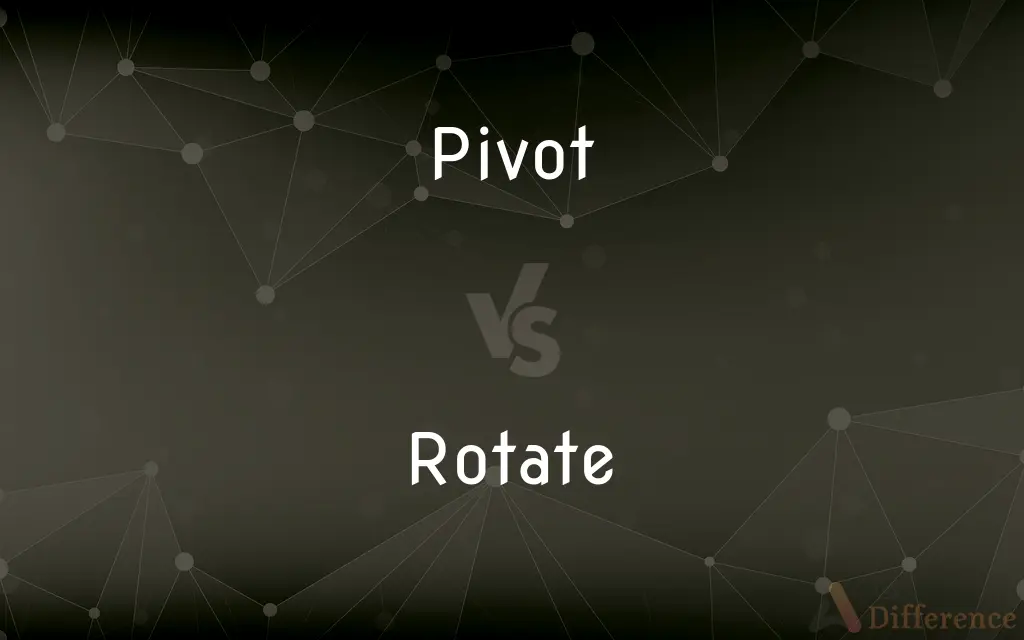Pivot vs. Rotate — What's the Difference?
Edited by Tayyaba Rehman — By Maham Liaqat — Updated on April 5, 2024
Pivot refers to turning around a fixed point, often implying a change in direction or strategy, while rotate involves turning around an axis or center point, commonly used in spatial contexts.

Difference Between Pivot and Rotate
Table of Contents
ADVERTISEMENT
Key Differences
Pivoting usually implies a change in direction, strategy, or focus, especially in contexts like business or personal decisions. It suggests movement around a fixed point while maintaining a connection to that original point. On the other hand, rotating is more about a physical or abstract object turning around an axis or center, applicable in various fields from mechanics to computer graphics.
In business, a pivot might mean shifting a company's business strategy to adapt to market demands. This could involve changing the product, target market, or business model. Whereas rotation can refer to changes in roles within a company or shifts in job responsibilities, but it retains the original structure and goals.
In terms of motion, pivoting often involves limited movement around a specific point or axis, like a basketball player pivoting on one foot. In contrast, rotation implies a full 360-degree movement, which could be around the object’s own axis or an external point, as planets rotate around their axes and revolve around the sun.
Pivoting is also a term used in software development, referring to a significant change in a project's direction after learning from failures and feedback. This is different from rotating, which might be used in software to describe the action of objects or elements, like rotating an image or a model in a 3D space.
In mathematics, a pivot point refers to a central point of rotation in matrix operations or algorithms, crucial for solving systems of linear equations. Rotation in mathematics, however, describes the movement of a shape around a center point, maintaining the same distance from that center throughout the movement.
ADVERTISEMENT
Comparison Chart
Definition
Turning around a fixed point, often implying strategic change.
Turning around an axis or center, used in spatial contexts.
Context
Business strategies, decisions, limited movement in sports.
Mechanical movements, spatial orientations, job roles.
Movement
Limited around a fixed point or axis.
Full 360-degree movement around an axis or center.
Field of Use
Business, sports, software development.
Mechanics, computer graphics, mathematics.
Purpose
To adapt or change direction.
To move or orient in space.
Compare with Definitions
Pivot
To turn or rotate around a fixed point, especially to change direction.
The player pivoted to face the goal.
Rotate
A systematic way of changing positions or roles.
Nurses rotate shifts to ensure 24-hour care.
Pivot
A central point or principle on which a mechanism turns or oscillates.
The seesaw moves on a central pivot.
Rotate
To cycle through a sequence or series.
The menu rotates weekly to offer variety.
Pivot
In business, a significant strategic change.
The startup pivoted from a product to a service model.
Rotate
In computer graphics, to turn an object around a fixed point.
The designer rotated the image for better alignment.
Pivot
In software development, to change project direction based on feedback.
After beta testing, the team pivoted to focus on user-friendly features.
Rotate
To turn around an internal axis or point.
The Earth rotates on its axis once every 24 hours.
Pivot
To change opinions, strategies, or decisions.
The politician pivoted on the issue after public feedback.
Rotate
In mechanics, a movement around an axis.
The gears rotate to power the machine.
Pivot
The central point, pin, or shaft on which a mechanism turns or oscillates.
Rotate
To turn around on an axis or center.
Pivot
Turn on or as if on a pivot
He swung round, pivoting on his heel
Rotate
To proceed in sequence; take turns or alternate
Interns will rotate through the various departments.
Pivot
A short rod or shaft on which a related part rotates or swings.
Rotate
To cause to turn on an axis or center.
Pivot
A person or thing on which something depends; the central or crucial factor
“The pivot of the whole affair was the stupidity of some admiral” (Joseph Conrad).
Rotate
To plant or grow (crops) in a fixed order of succession.
Pivot
The act of turning on a pivot.
Rotate
To cause to alternate or proceed in sequence
The coach rotates her players frequently near the end of the game.
Pivot
A dramatic change in policy, position, or strategy
“President Obama's decision to cancel a planned week-long trip to Asia ... is raising questions across Washington about the administration's vaunted pivot to Asia” (Howard LaFranchi).
Rotate
Having radiating parts; wheel-shaped.
Pivot
A person around which a formation of marching people turns.
Rotate
(intransitive) To spin, turn, or revolve.
He rotated in his chair to face me.
The earth rotates.
Pivot
(Sports) A player who plays at the center of the offense.
Rotate
(intransitive) To advance through a sequence; to take turns.
The nurses' shifts rotate each week.
Pivot
A position taken by an offensive player usually facing away from the basket near the foul line to relay passes, attempt a shot, or set screens.
Rotate
To lift the nose during takeoff, just prior to liftoff.
The aircraft rotates at sixty knots.
Pivot
The stationary foot around which the ball handler is allowed to pivot without dribbling.
Rotate
(transitive) To spin, turn, or revolve something.
Rotate the dial to the left.
Pivot
To mount on, attach by, or provide with a pivot or pivots.
Rotate
(transitive) To advance something through a sequence; to allocate or deploy in turns.
Pivot
To cause to rotate, revolve, or turn
Pivoted the telescope toward the island.
Rotate
(transitive) To replace older materials or to place older materials in front of newer ones so that older ones get used first.
The supermarket rotates the stock daily so that old foods don't sit around.
Pivot
To turn on a pivot.
Rotate
(transitive) To grow or plant (crops) in a certain order.
Pivot
To depend or be centered
“The plot ... lacks direction, pivoting on Hamlet's incertitude” (G. Wilson Knight).
Rotate
Having the parts spreading out like a wheel; wheel-shaped.
A rotate spicule or scale; a rotate corolla
Pivot
To make a dramatic change in policy, position, or strategy
“If you start pivoting, you're not being honest with people” (Donald Trump).
Rotate
Having the parts spreading out like a wheel; wheel-shaped; as, a rotate spicule or scale; a rotate corolla, i.e., a monopetalous corolla with a flattish border, and no tube or a very short one.
Pivot
A thing on which something turns; specifically a metal pointed pin or short shaft in machinery, such as the end of an axle or spindle.
Rotate
To turn, as a wheel, round an axis; to revolve.
Pivot
Something or someone having a paramount significance in a certain situation.
Rotate
To perform any act, function, or operation in turn, to hold office in turn; as, to rotate in office.
Pivot
Act of turning on one foot.
Rotate
To cause to turn round or revolve, as a wheel around an axle.
Pivot
(military) The officer or soldier who simply turns in his place while the company or line moves around him in wheeling.
Rotate
To cause to succeed in turn; esp., to cause to succeed some one, or to be succeeded by some one, in office.
Pivot
(roller derby) A player with responsibility for co-ordinating their team in a particular jam.
Rotate
Turn on or around an axis or a center;
The Earth revolves around the Sun
The lamb roast rotates on a spit over the fire
Pivot
(computing) An element of a set to be sorted that is chosen as a midpoint, so as to divide the other elements into two groups to be dealt with recursively.
Rotate
Exchange on a regular basis;
We rotate the lead soprano every night
Pivot
(computing) A pivot table.
Rotate
Cause to turn on an axis or center;
Rotate the handle
Pivot
(GUI) Any of a row of captioned elements used to navigate to subpages, rather like tabs.
Rotate
Perform a job or duty on a rotating basis;
Interns have to rotate for a few months
Pivot
(mathematics) An element of a matrix that is used as a focus for row operations, such as dividing the row by the pivot, or adding multiples of the row to other rows making all other values in the pivot column 0.
Rotate
Turn outward;
These birds can splay out their toes
Ballet dancers can rotate their legs out by 90 degrees
Pivot
(Canadian football) A quarterback.
Rotate
Plant or grow in a fixed cyclic order of succession;
We rotate the crops so as to maximize the use of the soil
Pivot
(handball) A circle runner.
Pivot
A shift during a general election in a political candidate's messaging to reflect plans and values more moderate than those advocated during the primary.
Pivot
(intransitive) To turn on an exact spot.
Pivot
To make a sudden or swift change in strategy, policy, etc.
Pivot
To change the direction of a business, usually in response to changes in the market.
Pivot
To shift a political candidate's messaging during a general election to reflect plans and values more moderate than those advocated during the primary.
Pivot
A fixed pin or short axis, on the end of which a wheel or other body turns.
Pivot
The end of a shaft or arbor which rests and turns in a support; as, the pivot of an arbor in a watch.
Pivot
Hence, figuratively: A turning point or condition; that on which important results depend; as, the pivot of an enterprise.
Pivot
The officer or soldier who simply turns in his place whike the company or line moves around him in wheeling; - called also pivot man.
Pivot
To place on a pivot.
Pivot
The person in a rank around whom the others wheel and maneuver
Pivot
Axis consisting of a short shaft that supports something that turns
Pivot
The act of turning on (or as if on) a pivot;
The golfer went to the driving range to practice his pivot
Pivot
Turn on a pivot
Common Curiosities
What is a pivot point in mathematics?
A pivot point in mathematics is a central point in matrix operations or algorithms, around which other elements are adjusted or calculated.
How do pivot and rotate differ in business?
In business, pivoting refers to a strategic shift or change in direction, while rotating might involve changes in roles, responsibilities, or job positions without altering the core business strategy.
What does it mean to pivot?
To pivot means to make a significant change in direction, strategy, or focus, often while maintaining a foundational element.
What is rotating?
Rotating involves turning or moving around an axis or center point, applicable in physical, spatial, and abstract contexts.
How do sports use the concept of pivoting?
In sports, pivoting often refers to an athlete turning around a fixed foot or point to change direction without losing balance or position.
How does rotation apply to computer graphics?
In computer graphics, rotation refers to turning an image, shape, or model around a fixed point or axis to achieve the desired orientation.
Why is rotation important in job roles?
Rotation in job roles can enhance skill diversity, prevent burnout, and ensure comprehensive understanding and functionality within a team or organization.
Can a physical object both pivot and rotate?
Yes, a physical object can pivot around a specific point or rotate around its axis or a central point, depending on the forces applied and the context.
Can rotation happen without movement from the original place?
Yes, rotation can occur around an object’s own axis without it moving from its original location, as seen with spinning tops or rotating planets.
How do you determine when to pivot?
Deciding to pivot usually involves assessing current strategies' effectiveness, market feedback, and the potential for growth or improvement in a new direction.
Is pivoting always a response to failure?
Not always. While pivoting can be a response to challenges or failures, it can also be a proactive strategy to seize new opportunities.
What makes an object rotate?
An object rotates due to forces or movements applied in a manner that causes it to turn around an axis or point.
How do pivot and rotate differ in software development?
In software development, pivoting refers to changing the direction of a project based on feedback, while rotation could describe the visual or functional reorientation of elements within the software.
What are the benefits of rotating objects in spatial analysis?
Rotating objects in spatial analysis can provide different perspectives, reveal hidden patterns, and improve understanding of spatial relationships.
What role does pivot play in decision-making?
Pivot plays a critical role in decision-making by allowing individuals or organizations to adapt and change direction based on new insights or changing circumstances.
Share Your Discovery

Previous Comparison
Artwork vs. Art
Next Comparison
You vs. ThouAuthor Spotlight
Written by
Maham LiaqatEdited by
Tayyaba RehmanTayyaba Rehman is a distinguished writer, currently serving as a primary contributor to askdifference.com. As a researcher in semantics and etymology, Tayyaba's passion for the complexity of languages and their distinctions has found a perfect home on the platform. Tayyaba delves into the intricacies of language, distinguishing between commonly confused words and phrases, thereby providing clarity for readers worldwide.














































